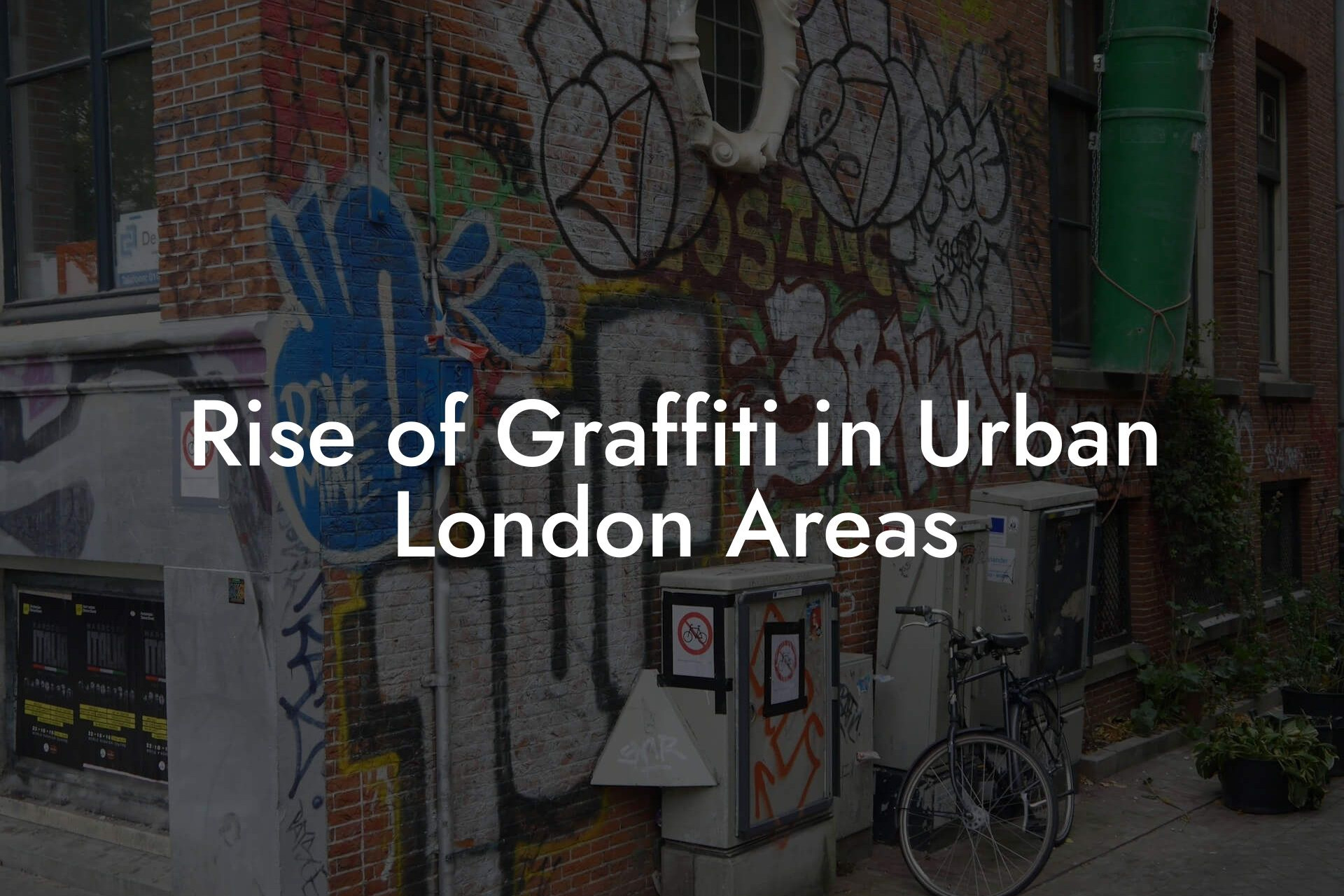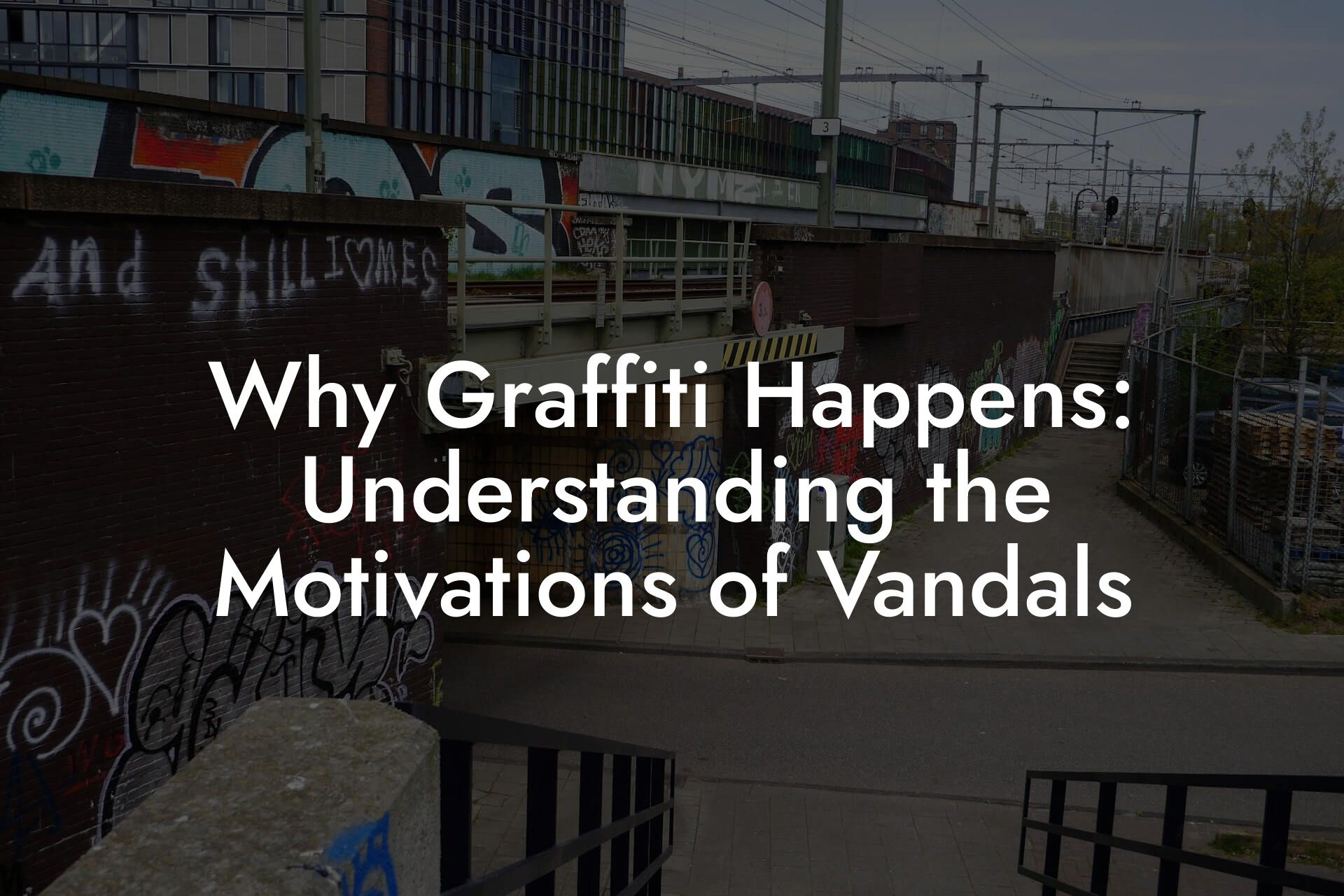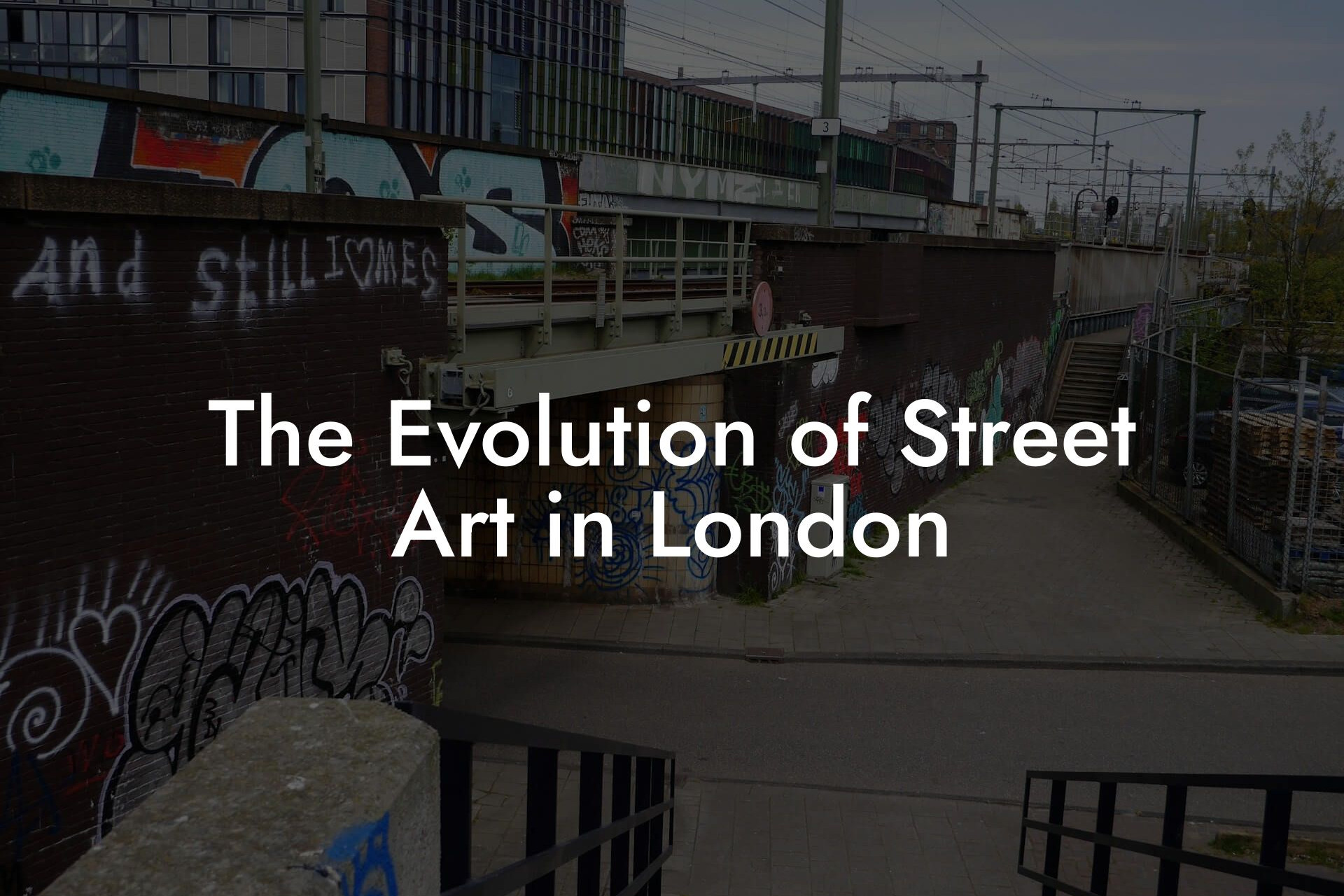Graffiti and street art are two terms that are often used interchangeably, but they have distinct differences in terms of their meaning, purpose, and legality. As a business that specializes in graffiti removal and vandalism clean-up in London, UK, we at Graffiti Removal London have seen our fair share of both graffiti and street art. In this article, we will delve into the world of graffiti and street art, exploring their histories, differences, and the often-blurred lines between them.
Table of Contents
- A Brief History of Graffiti
- The Rise of Street Art
- The Key Differences Between Graffiti and Street Art
- The Legal Implications of Graffiti and Street Art
- The Impact of Graffiti and Street Art on Urban Spaces
- The Role of Graffiti Removal in Urban Spaces
- Conclusion: Where Is the Line?
- Frequently Asked Questions
A Brief History of Graffiti
Graffiti has a rich and diverse history that spans thousands of years. The word "graffiti" comes from the Greek word "graphien," which means "to write." The earliest recorded instances of graffiti date back to ancient civilizations in Greece, Rome, and Egypt, where people would scribble messages, poems, and even political slogans on walls and buildings. In modern times, graffiti gained popularity in the 1970s and 1980s in New York City, where it became a symbol of rebellion and nonconformity. Today, graffiti can be found in cities all around the world, often carrying messages of social and political activism.
The Rise of Street Art
Street art, on the other hand, is a more recent phenomenon that emerged in the 1990s and early 2000s. Street art is a broader term that encompasses a wide range of artistic expressions, including stencils, murals, mosaics, and sculptures. Street art often has a more positive connotation than graffiti, as it is often commissioned by local authorities or property owners and is seen as a way to beautify urban spaces. Street art has become a popular form of self-expression and has given rise to a new generation of artists who use the streets as their canvas.
The Key Differences Between Graffiti and Street Art
So, what sets graffiti apart from street art? The main difference lies in their purpose and legality. Graffiti is often seen as a form of vandalism, as it is typically done without permission and can cause damage to property. Street art, on the other hand, is often commissioned or tolerated by local authorities and is seen as a way to add character and beauty to urban spaces. Graffiti often carries a message of rebellion or social activism, while street art is more focused on aesthetics and self-expression.
The Legal Implications of Graffiti and Street Art
From a legal standpoint, graffiti is often considered a criminal offense, punishable by fines or even imprisonment. In the UK, the Criminal Damage Act of 1971 makes it an offense to damage or destroy property without permission. Street art, on the other hand, is often legal, as long as it is done with the permission of the property owner. However, the line between graffiti and street art can be blurry, and what is considered art by one person may be seen as vandalism by another.
The Impact of Graffiti and Street Art on Urban Spaces
Graffiti and street art can have a significant impact on urban spaces, both positively and negatively. On the one hand, graffiti can be seen as a blight on urban landscapes, contributing to a sense of decay and neglect. On the other hand, street art can add character and beauty to urban spaces, making them more attractive and vibrant. Street art can also play a role in urban regeneration, as it can help to revitalize neglected areas and attract new businesses and investment.
The Role of Graffiti Removal in Urban Spaces
As a business that specializes in graffiti removal and vandalism clean-up, we at Graffiti Removal London have seen firsthand the impact that graffiti can have on urban spaces. Our team of experts uses the latest techniques and equipment to remove graffiti quickly and effectively, helping to restore property values and maintain a sense of community pride. We believe that graffiti removal is an important part of maintaining a clean and safe urban environment, and we work closely with local authorities and property owners to provide a comprehensive graffiti removal service.
Conclusion: Where Is the Line?
In conclusion, the line between graffiti and street art is often blurred, and what is considered art by one person may be seen as vandalism by another. While graffiti can be seen as a form of rebellion and social activism, street art is often more focused on aesthetics and self-expression. As a business that specializes in graffiti removal and vandalism clean-up, we recognize the importance of maintaining a balance between artistic expression and respect for property rights. By understanding the differences between graffiti and street art, we can work towards creating urban spaces that are both beautiful and respectful of the community.
At Graffiti Removal London, we are committed to providing a comprehensive graffiti removal service that helps to maintain a clean and safe urban environment. If you are a property owner or local authority in need of graffiti removal services, contact us today to learn more about our services and how we can help.
Frequently Asked Questions
What is the difference between graffiti and street art?
Graffiti and street art are often used interchangeably, but they have distinct differences. Graffiti typically involves unauthorized writing or drawing on a surface, often with the intention of causing damage or vandalism. Street art, on the other hand, is a broader term that encompasses a wide range of artistic expressions, including murals, stencil art, and installations, which are often created with the permission of the property owner.
Is graffiti illegal?
In most cases, yes. Graffiti is considered an act of vandalism and is illegal in many jurisdictions. It can result in fines, community service, or even criminal charges. However, some cities have designated areas for graffiti and street art, where artists can create their work legally.
What is the history of graffiti?
Graffiti has a rich history that dates back to ancient civilizations. The word "graffiti" comes from the Italian word "graffio," meaning "scratch." In ancient Greece and Rome, graffiti was used to express political opinions, make announcements, and even leave love notes. In modern times, graffiti emerged as a form of urban art in the 1970s and 1980s, particularly in New York City.
What is the difference between graffiti and tagging?
Tagging refers to the act of writing one's name or initials on a surface, often in a quick and simple manner. Graffiti, on the other hand, can involve more complex designs, patterns, or messages. While tagging is a form of graffiti, not all graffiti is tagging.
Is street art a form of vandalism?
Not necessarily. While some street art may be created illegally, many artists work with property owners to create murals and installations that are legal and even commissioned. Street art can also be a powerful tool for social commentary, community engagement, and urban revitalization.
How do I report graffiti in London?
If you're a resident or business owner in London, you can report graffiti to your local council or the police. You can also contact Graffiti Removal London, a specialized service that provides graffiti removal and vandalism cleanup solutions.
How do I remove graffiti from my property?
Removing graffiti can be a challenging task, and it's often best left to professionals. Graffiti Removal London offers expert graffiti removal services using eco-friendly products and specialized techniques. If you're unsure about how to remove graffiti from your property, it's best to contact a professional service to avoid damaging the surface or spreading the graffiti.
Can I paint over graffiti?
While painting over graffiti may seem like a quick fix, it's not always the most effective solution. Graffiti can seep through paint, and the underlying surface may require specialized cleaning and preparation before repainting. It's best to consult with a professional graffiti removal service to ensure the graffiti is completely removed and the surface is properly prepared for repainting.
How can I prevent graffiti on my property?
There are several ways to prevent graffiti on your property, including installing security cameras, improving lighting, and using anti-graffiti coatings. You can also work with local authorities and community groups to implement graffiti prevention programs and promote urban art initiatives.
What are the consequences of graffiti?
Graffiti can have serious consequences, including property damage, decreased property values, and negative impacts on local businesses and communities. It can also lead to criminal charges and fines for those responsible.
How does graffiti affect local businesses?
Graffiti can have a significant impact on local businesses, including decreased foot traffic, lost revenue, and a negative perception of the area. It can also lead to increased security costs and cleanup expenses.
Can graffiti be a form of social commentary?
Yes, graffiti can be a powerful tool for social commentary and political expression. Many artists use graffiti to raise awareness about social issues, challenge authority, and promote positive change.
What is the role of graffiti in urban culture?
Graffiti plays a significant role in urban culture, particularly in urban areas where it can be a form of self-expression and community engagement. It can also be a way to reclaim public spaces and challenge mainstream norms.
How can I support street artists?
You can support street artists by attending urban art festivals, purchasing their work, and promoting their art on social media. You can also support initiatives that provide legal walls and spaces for street artists to create their work.
Is graffiti a form of vandalism or art?
This is a complex and debated topic. While some view graffiti as a form of vandalism, others see it as a legitimate form of artistic expression. Ultimately, the distinction between vandalism and art depends on the context, intent, and impact of the graffiti.
What is the difference between graffiti and stencil art?
Stencil art is a specific technique used to create images or designs using stencils and spray paint. Graffiti, on the other hand, is a broader term that encompasses a wide range of techniques and styles.
Can I create my own street art?
Yes, but it's essential to ensure that you have permission from the property owner and comply with local laws and regulations. You can also participate in legal street art initiatives and workshops to learn from experienced artists and gain skills.
How can I learn more about graffiti and street art?
You can learn more about graffiti and street art by attending urban art festivals, reading books and online resources, and following street artists on social media. You can also take guided tours or workshops to gain a deeper understanding of the culture and techniques involved.
What is the future of graffiti and street art?
The future of graffiti and street art is uncertain, but it's likely that these forms of expression will continue to evolve and adapt to changing urban landscapes and social norms. As cities become more densely populated and urbanization increases, graffiti and street art may play an increasingly important role in shaping urban culture and identity.
How can I report vandalism in London?
If you're a resident or business owner in London, you can report vandalism to the police or your local council. You can also contact Graffiti Removal London, a specialized service that provides vandalism cleanup and graffiti removal solutions.
What is the cost of graffiti removal?
The cost of graffiti removal varies depending on the size, location, and type of graffiti. Graffiti Removal London offers competitive pricing and customized solutions for businesses and property owners in London.
How long does graffiti removal take?
The time it takes to remove graffiti depends on the complexity of the job and the type of surface involved. Graffiti Removal London's experienced team can typically remove graffiti quickly and efficiently, minimizing downtime and disruption to your business or daily activities.
Is graffiti removal environmentally friendly?
Graffiti Removal London uses eco-friendly products and techniques to minimize the environmental impact of graffiti removal. Our team is committed to providing sustainable solutions that prioritize the health and safety of people and the environment.
Toby Doherty
Toby Doherty is a seasoned graffiti removal expert with over 20 years of experience in the industry. Throughout his career, Toby has helped countless businesses and property owners in London maintain clean, graffiti-free spaces. His extensive knowledge of graffiti removal techniques, from eco-friendly solutions to advanced technologies like laser cleaning, makes him a trusted authority in the field. Passionate about restoring urban environments, Toby combines his hands-on expertise with a commitment to staying up-to-date on the latest industry trends and innovations. When he’s not out in the field, Toby shares his insights through detailed articles, offering practical advice on everything from graffiti prevention to legal considerations.



